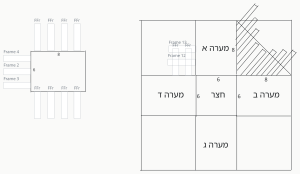Bava Batra 101
וְרׇחְבָּן שִׁשָּׁה.
and their width is six handbreadths.
רַבִּי שִׁמְעוֹן אוֹמֵר: עוֹשֶׂה תּוֹכָהּ שֶׁל מְעָרָה שֵׁשׁ אַמּוֹת עַל שְׁמוֹנֶה, וּפוֹתֵחַ לְתוֹכָהּ שְׁלֹשָׁה עָשָׂר כּוּךְ – אַרְבָּעָה מִכָּאן, וְאַרְבָּעָה מִכָּאן, וּשְׁלֹשָׁה מִכְּנֶגְדָּן, וְאֶחָד מִימִין הַפֶּתַח, וְאֶחָד מִן הַשְּׂמֹאל.
Rabbi Shimon says: He should construct the inside of each burial chamber six cubits wide by eight cubits long and open up into the chamber, by digging into its walls, thirteen burial niches. Four niches should be opened up from the wall here, along the length of the chamber, and four from there, along the other side, and three niches from the wall facing the entrance, and one from the right of the entrance and another one from the left.
וְעוֹשֶׂה חָצֵר עַל פִּי הַמְּעָרָה שֵׁשׁ עַל שֵׁשׁ, כִּמְלֹא הַמִּטָּה וְקוֹבְרֶיהָ.
The mishna describes the general structure of the catacomb: And he must fashion a courtyard at the entrance of the burial chamber that should be six cubits by six cubits, which is equal to the combined length of the bier of the deceased and those who bury him, to ensure adequate room for the burial to take place.
וּפוֹתֵחַ לְתוֹכָהּ שְׁתֵּי מְעָרוֹת – אַחַת מִכָּאן וְאַחַת מִכָּאן. רַבִּי שִׁמְעוֹן אוֹמֵר: אַרְבַּע לְאַרְבַּע רוּחוֹתֶיהָ.
And he should open up two burial chambers into the courtyard, one from here and one from there, i.e., on opposite sides of the courtyard. Rabbi Shimon says: He should open up four burial chambers, one on each of the courtyard’s four sides.
רַבָּן שִׁמְעוֹן בֶּן גַּמְלִיאֵל אוֹמֵר: הַכֹּל לְפִי הַסֶּלַע.
Rabban Shimon ben Gamliel says: Everything is dependent on the nature of the bedrock. If the bedrock is hard and strong it will be able to accommodate more niches, which will be more closely packed together, with less bedrock between them. If the bedrock is softer, fewer and more sparsely spaced niches should be formed.
גְּמָ׳ הָנֵי תְּרֵי לְהֵיכָא שָׁדֵי לְהוּ? אִי לְבָרַאי – הָא קָמִיתַּדְשִׁי לְהוּ! וְתוּ, הָא תְּנַן: חֲצַר הַקֶּבֶר, הָעוֹמֵד בְּתוֹכוֹ – טָהוֹר!
GEMARA: In Rabbi Shimon’s depiction of a burial chamber, he states that two niches should be opened up, one from the right of the entrance and one from the left. The Gemara asks: These two niches, in which direction does he set them? If they are directed toward the outside of the chamber, i.e., under the floor of the courtyard, won’t people trample over them when they enter the courtyard, which is improper? And furthermore, didn’t we learn in the mishna (Oholot 15:8): With regard to the courtyard of a catacomb, one who stands inside it is ritually pure because it can be presumed that he did not stand over a dead body? Clearly, these niches are not to be dug underneath the courtyard.
אָמַר רַבִּי יוֹסֵי בְּרַבִּי חֲנִינָא: דְּעָבֵיד לְהוּ כְּמִין נֶגֶר.
Rabbi Yosei, son of Rabbi Ḥanina, said: He makes these two niches at the side of the entrance, vertically, like a door bolt.
וְהָא אָמַר רַבִּי יוֹחָנָן:
The Gemara challenges this explanation: But doesn’t Rabbi Yoḥanan say with regard to the burial of people in a vertical position:
קְבוּרַת חֲמוֹרִים הִיא זוֹ!
This is like a burial of donkeys and is disrespectful.
לְרַבִּי יוֹחָנָן, דְּעָבֵיד לְהוּ בְּקֶרֶן זָוִית.
The Gemara answers: According to the opinion of Rabbi Yoḥanan, each of these two niches is formed in a different corner of the chamber, aligned diagonally away from the chamber’s cavity.
וְהָא נָגְעִי כּוּכִין לַהֲדָדֵי!
The Gemara challenges: But if so, won’t the niches located around the corners touch one another? According to Rabbi Yoḥanan’s suggestion, there are, in fact, three niches located at each of the two back corners. One is recessed into the wall of the length of the chamber, at right angles to it, another is recessed into the back wall of the chamber, also at right angles to it, and a third that extends diagonally away from the chamber. The ends of these three niches will overlap, causing there to be too little space in them to fulfill the minimum required measurement.
אָמַר רַב אָשֵׁי: בְּמַעֲמִיק. דְּאִי לָא תֵּימָא הָכִי, אַרְבַּע מְעָרוֹת לְרַבִּי שִׁמְעוֹן – הֵיכִי עָבֵיד לְהוּ? הָא קָא נָגְעִי כּוּכִין לַהֲדָדֵי! אֶלָּא בְּמַעֲמִיק; הָכָא נָמֵי בְּמַעֲמִיק.
Rav Ashi said: It is possible to do this where, when constructing the niches that extend diagonally away from the chamber, one deepens them, i.e., forms them lower down in the wall than the other niches adjacent to them. As, if you do not say that this is a solution, then how could the four chambers depicted by Rabbi Shimon be constructed? Won’t the niches touch one another? The niches of one chamber will overlap those of the chamber adjacent to it. Rather, it is possible to arrange the niches only where, when constructing the niches of two chambers at opposite ends of the courtyard, one deepens them, i.e., forms them lower down in the wall than the niches of the other two chambers that are adjacent to them. Here too, it is a case in which one deepens them.
רַב הוּנָא בְּרֵיהּ דְּרַב יְהוֹשֻׁעַ אָמַר: אַרְבַּע מְעָרוֹת לְרַבִּי שִׁמְעוֹן – דְּעָבֵיד לְהוּ כִּי חֲרוּתָא.
Rav Huna, son of Rav Yehoshua, said that there is an alternative explanation: It is possible to fashion the four chambers depicted by Rabbi Shimon where one constructs them so that all the niches extend diagonally away from the cavity of the chamber like the leaves of a palm branch, which have spread out from its spine. If formed in this way, the niches of adjacent chambers will not overlap, even if they are at the same depth in the ground.
וְהָא דְּרַב הוּנָא בְּרֵיהּ דְּרַב יְהוֹשֻׁעַ – בְּרוּתָא הִיא. מִכְּדֵי כׇּל אַמְּתָא בְּרִיבּוּעָא אַמְּתָא וּתְרֵי חוּמְשֵׁי בַּאֲלַכְסוֹנָא; כַּמָּה הָוֵי לְהוּ? חַד סְרֵי וְחוּמְשָׁא; כּוּכִין כַּמָּה הָווּ? תְּמָנְיָא; תְּמָנְיָא בְּחַד סְרֵי וְחוּמְשָׁא הֵיכִי מַשְׁכַּחַתְּ לַהּ? אֶלָּא הָא דְּרַב הוּנָא בְּרֵיהּ דְּרַב יְהוֹשֻׁעַ – בְּרוּתָא הִיא.
The Gemara notes: And this statement of Rav Huna, son of Rav Yehoshua, is an error, because it is not possible to form all the niches in this way, since the length of the diagonal of every square whose side is one cubit is one and two-fifths cubits. Each chamber is eight cubits long, which means that between two adjacent chambers, placed at right angles to each other, there is a square area of eight cubits by eight cubits into which the niches of those two chambers must be formed. How much is the diagonal of that area? Eleven and one-fifth cubits. How many niches have to fit in that space? Eight. How can you find that eight niches can possibly fit into eleven and one-fifth cubits? Each of the niches is a cubit wide, and there must be a cubit wall of bedrock between each niche. To accommodate this once would need an area of at least fifteen cubits. Rather, this statement of Rav Huna, son of Rav Yehoshua, is in error.
וְאִי בָּעֵית אֵימָא, כִּדְאָמַר רַב שִׁישָׁא בְּרֵיהּ דְּרַב אִידִי: בְּנִיפְלֵי; הָכָא נָמֵי בְּנִיפְלֵי.
The Gemara provides an alternative solution to the problem of the niches at the corners overlapping. Or if you wish, say as Rav Sheisha, son of Rav Idi, said in answer to a similar question: It is referring to non-viable newborns, which require only very small burial niches. Similarly, here also, the niches at the corners of the chambers were used for non-viable newborns.
תְּנַן הָתָם: הַמּוֹצֵא מֵת מוּשְׁכָּב כְּדַרְכּוֹ, נוֹטְלוֹ וְאֶת תְּפוּסָתוֹ. שְׁנַיִם – נוֹטְלָן וְאֶת תְּפוּסָתָן.
§ The Gemara considers another mishna that relates to the structure of a catacomb: We learned in a mishna there (Nazir 64b): With regard to one who finds a corpse while inspecting a place that was not previously established as a cemetery, to ensure that it is free of ritual impurity, and the corpse is lying in the usual manner of Jewish burial, he removes it from there and also removes its surrounding earth. And similarly, if he finds two corpses buried in the usual manner, he removes them and their surrounding earth. Since only one or two corpses were found, it may be assumed that the area is not a cemetery; therefore, the corpses may be removed.






















